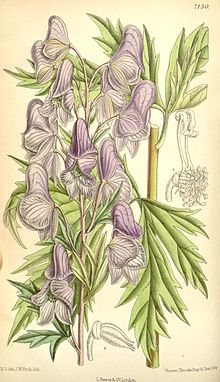Aconitum fischeri: Difference between revisions
Content deleted Content added
Updating taxobox classification to the APG III system and/or other cleanup using AWB |
No edit summary |
||
| Line 14: | Line 14: | ||
|}} |
|}} |
||
'''''Aconitum fischeri''''' is a blue colored flowering plant species of the genus ''[[Aconitum]]'' in the family [[Ranunculaceae]]. Plants bloom early-late summer, native in Korea and Siberia and cultivated in gardens in temperate zones for its showy flowers. |
'''''Aconitum fischeri''''' is a blue colored flowering plant species of the genus ''[[Aconitum]]'' in the family [[Ranunculaceae]]. Plants bloom early-late summer, native in Korea and Siberia and cultivated in gardens in temperate zones for its showy flowers. The plant contains poisonous [[aconite]], but according to ancient Chinese medical lore, it is carefully measured, prepared, and used, it is beneficial in the treatment of colds, coughs, and fevers. If the measuring is in the slightest degree inaccurate, however, it is pure poison.<ref>Pearl S. Buck, "The Three Daughters of Madame Liang," London: Moyer Bell, 1969, at p. 220.</ref> |
||
[[Category:Ranunculaceae]] |
[[Category:Ranunculaceae]] |
||
Revision as of 14:28, 3 August 2013
| Aconitum fischeri | |
|---|---|

| |
| Aconitum fischeri | |
| Scientific classification | |
| Kingdom: | |
| (unranked): | |
| (unranked): | |
| Order: | |
| Family: | |
| Genus: | |
| Species: | A. fischeri
|
| Binomial name | |
| Aconitum fischeri | |
Aconitum fischeri is a blue colored flowering plant species of the genus Aconitum in the family Ranunculaceae. Plants bloom early-late summer, native in Korea and Siberia and cultivated in gardens in temperate zones for its showy flowers. The plant contains poisonous aconite, but according to ancient Chinese medical lore, it is carefully measured, prepared, and used, it is beneficial in the treatment of colds, coughs, and fevers. If the measuring is in the slightest degree inaccurate, however, it is pure poison.[1]
- ^ Pearl S. Buck, "The Three Daughters of Madame Liang," London: Moyer Bell, 1969, at p. 220.
